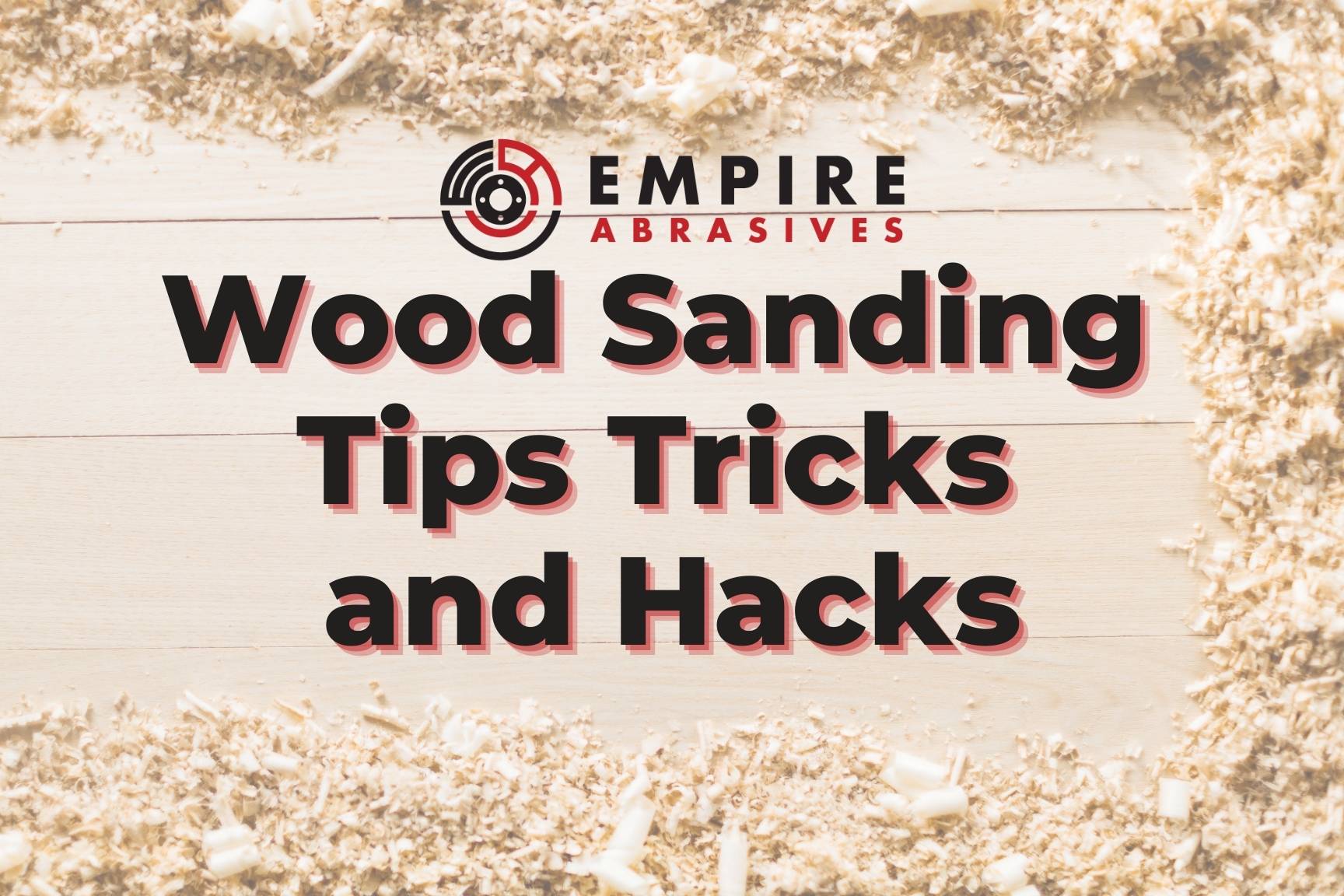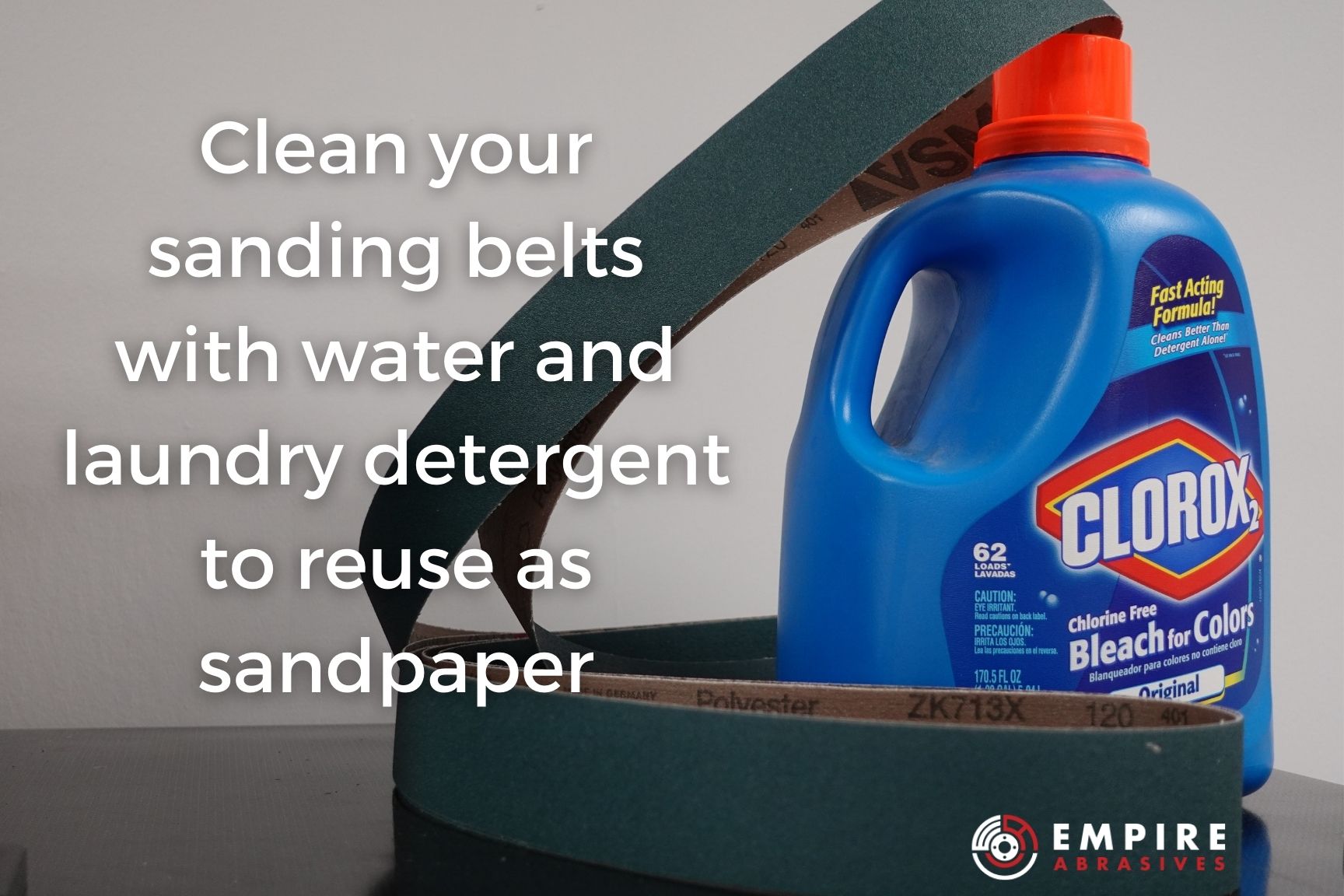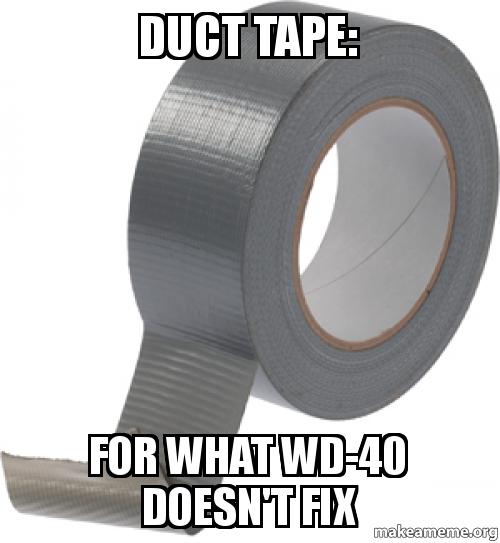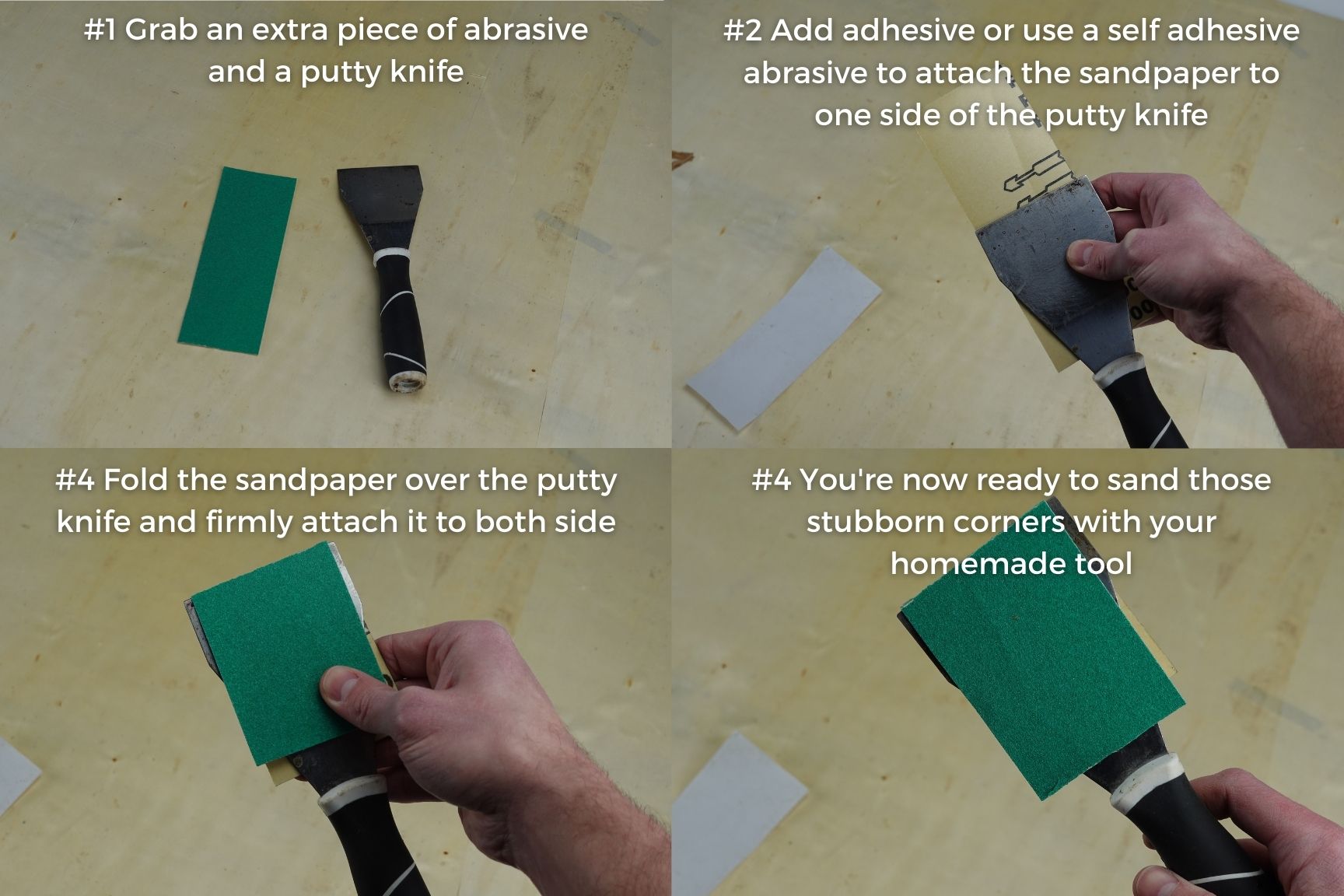How to Make a Piece of Sandpaper New Again

Nosotros wanted to share some amazing tips and tricks for sanding wood we've learned from our customers and from falling downwards some rabbit holes of YouTube videos about abrasives. You know yous've been in that location.
These tips and tricks will assist y'all extend the life of your current abrasives, notice creative ways to reuse abrasives you thought were ready for the trash, and some overall bang-up woodworking tool hacks.
Why/How Yous Should Wash Your Sanding Belts

Simply considering you've used a belt doesn't mean the life-cycle of that belt is over. There is yet plenty of life in near used sanding belts...you just demand to exercise a fiddling work that tin can salve you some money on other abrasive products.
Washing out the contaminants and debris of a used belt sander belt makes them set to reuse as fleck sand paper for other jobs.
To really get the belts clean, nosotros recommend starting with a sanding chugalug cleaning stick to remove the most embedded debris.
Subsequently you retrieve you've done enough with the cleaning stick, let your belts soak in a bucket or tub of hot water with a tiny bit of laundry detergent for virtually 10 minutes. Remove the belts and give them a good scrubbing with a strong-bristle brush -- we would recommend a plastic brush for this step.
Let them to fully dry, and so cut the chugalug down to smaller strips y'all can use for paw sanding some other project.
**Delight note that once you've washed your belts like this, they should non exist used again on a belt sander. The h2o and detergent will degrade the cloth backing which will likely split up when running on a chugalug sander.**
Wet Saw Cut with a (Tool) Box of Crayons
Using a wet saw can exist a boring task as you try your hardest to make sure your cuts are straight while managing to keep your work area make clean. When you lot brand your cut guide lines, y'all want something that won't wash away, but likewise don't want anything that volition permanently mark or damage the wood surface.
The quickest solution is a simple one found in about every habitation, peculiarly if you lot have kids. Pull your favorite vivid/bold color out of your crayon box to use for mark upwardly your woods surface. The crayon won't launder away from the moisture saw, only will easily wash off past mitt when y'all're washed cut.
How to Brand Your Own Woods File
A woodworking metallic hand file is an amazingly useful tool to accept, merely if you merely accept a small job or demand to hit some corners, you tin can create a makeshift wood file pretty easily. Whether yous are using scraps, pieces of onetime belts (like we mentioned in the first tip), or fresh sanding sheets, this is a quick DIY tool you lot tin can make anytime.
First, you lot only need to cut a piece of sandpaper (or other like sized abrasive) downward to fit around a apartment stick, like a paint stir stick or sturdy and straight piece of bit forest. Once you've done that, spray an adhesive or some type of glue to the back of the sandpaper and wrap it tightly around the stick. Hold information technology firm until it sets. At present you've got a quick homemade file and saved yourself a trip to Home Depot.
Instead of wrapping one dust sand newspaper around the wood block, you can likewise become a pace further like the video in a higher place. Y'all can hands glue a different dust or abrasive material to each side to make a much more versatile tool.
Make sure you label the handle with the grit paper you used and so you can use it again in the future.
You Should Utilise A Pencil When You Sand
Why? Information technology helps prevent you from oversanding and lets you lot know when to move onto the next dust. Whether you are resurfacing a floor or sanding an smaller project, a few unproblematic pencil marks can easily help you from oversanding and perchance ruining the wood surface.
To do the "pencil hack", rub the pencil firmly across the surface surface area you'll exist sanding. As y'all sand beyond this expanse, the pencil marks will disappear when you lot've done enough piece of work. Marking up the forest surface again with more than pencil and repeat on a finer grit. Keep doing the pencil trick every bit you sand away the surface with each higher grit until you've got the flat, fifty-fifty, smoothen surface you've been working towards.
This play a joke on will also allow you to see just how fast the surface is beingness sanded away, allowing yous to conform your speed or grit accordingly to brand sure you lot aren't sanding too deep into the forest.
Only remember the effectively the grit you'll be sanding with then the lighter the pencil shading should exist.
Label Your Sanding Discs Earlier Using
This isn't exactly an earth shattering trick, but it's a pocket-sized tip that'll salvage you some headaches if you remember to practise it.
If you lot're a fan of an annoying like our claw and loop sanding discs, you (hopefully) know that they can be reused multiple times before the abrasive grit finally wear out. However, as you employ them, the dust numbers on the labels tin can fade and get harder and harder to read faster than the actual annoying wears down.
We recommend labelling the backs on each of the sanding discs with permanent marker. The Sharpie ink should last a while so you don't take to gauge what grit or annoying is on the front end of the disc.
If yous don't want to graffiti up your discs and however want to be organized, nosotros also recommend sorting your discs in pocket-sized plastic bins labeled with the grit numbers. Simply remember to make sure to put it back immediately so they don't go mixed upwards.
Pool Noodles Can Change the Way You Sand
While it may seem a lilliputian odd at get-go for some of our master woodworkers, a dollar store pool noodle may carve out (cheesy pun totally intended) a permanent identify in your toolbox.
There are multiple ways you can set up these upward for woodworking, but nosotros've mostly seen these used as a makeshift sanding sponge that has requite and can exist used flat or rounded. If y'all're actress crafty you tin can make handles for them. But, this flexible foam is such a peachy and versatile base for abrasive materials.
When you attach sandpaper to it, you tin can hands shrink the foam to fit in or around so many different shapes and in otherwise awkward positions. Information technology's as well very easy to bandy out unlike sandpaper when you need to use dissimilar sandpaper grits.
They are extremely easy to cut through. You tin easily cut through them with a staff of life knife or whatever larger wide toothed blade to get the size and shape for each project. Sandpaper can as well be attached on the inside or outside of the noodle, depending on your needs.
Increase Sandpaper Strength for Hand Sanding
This tip works great when you are looking to utilise upwardly old sandpaper or those laundered sanding belt scraps mentioned in a higher place for freehand sanding. It's a great way to assist make it comfy to concur as well as increment the physical forcefulness of the abrasive backing using something everyone should have on hand...duct record.
It is a very elementary play a joke on of the merchandise. Just apply a strip of duct tape to the back of the abrasive sheet and you have a flexible sandpaper with increased durability. Y'all may want to label the duct record with a permanent marker if you're going to reuse this a few times.

Repurpose an Electric Toothbrush into a Mini Orbital Sander
This is a slap-up lilliputian fob if you need to go into a tight expanse simply only need or want one side to have an abrasive rather than using something similar a small 1" spiral ring that would have less focused sanding.
First, cut off all of the bristles from the toothbrush head*. You'll get improve results if you sand down the surface to get rid of any piddling stubborn pieces of bristle that y'all might take missed with a bract.
Next, cut out a small slice of PSA sanding disc, and then adhere it to the electrical toothbrush head. While yous can utilize whatsoever sandpaper with an adhesive spray, we would recommend using the mucilaginous back discs for an appropriate strength adhesive. If you end up really liking this, you can get multiple toothbrush heads for different grit ranges and labeling the head.
*Note - this but works with spinning toothbrushes and doesn't apply to vibrating toothbrushes like Philips Sonicare or Quip. You can usually find a inexpensive spinning electric toothbrush at a Target, CVS, or some dollar stores.
Sand Tight Corners without Dissentious Borders

Trying to sand tight corners and edges with raised borders tin can be tough without the right tools. You can easily terminate up scratching the raised wood around the area you want to sand or not existence able to get deep enough into the edges to evenly sand the wood. A dandy style to overcome this is using something like a putty knife or scraper with sandpaper attached.
This works fine by just folding a sandpaper canvass over the edge of the knife, but for bigger projects it'll be less of a hassle if you apply an adhesive sandpaper. If you lot're not using a cocky-adhesive annoying, you can likewise apply spray glue adhesive to one side of the putty pocketknife and attach some scrap sandpaper, folded over both sides. This will allow you to sand the difficult areas without scratching/sanding the adjacent wood.
How to Make Your Ain Wood Filler
While wood filler is pretty affordable, but nothing is more affordable than free. Next time yous're cut or grinding woods, it might be a expert idea to concord onto the saw dust for a fleck.
To make your own DIY woods filler mix sawdust with wood mucilage, or shellac like the video higher up, and apply to the pigsty. Allow the filler to dry out completely and so proceed to sand.
One of the biggest benefits to this over shop bought filler is the sawdust from the piece your working on volition have an almost exact matching color whereas woods filler can have a noticeably different coloring.
Why Swiffer Should Have a Place in Your Toolbox
After you worked so hard sanding everything down getting the perfect finish, you desire to brand sure you remove all of the debris from sanding and steel wool use. A normal rag unremarkably won't get all of the stubborn grit and steel fibers off of the surface.
One of the all-time, and cheapest, ways to remove the sandpaper dust and steel wool debris is a quick wipe with a dusting sail. These static cleaning dust sheets, like the ones on a Swiffer Sweeper, will clean upward the surface in seconds.
Source: https://www.empireabrasives.com/blog/wood-sanding-tips-tricks-hacks
0 Response to "How to Make a Piece of Sandpaper New Again"
Post a Comment